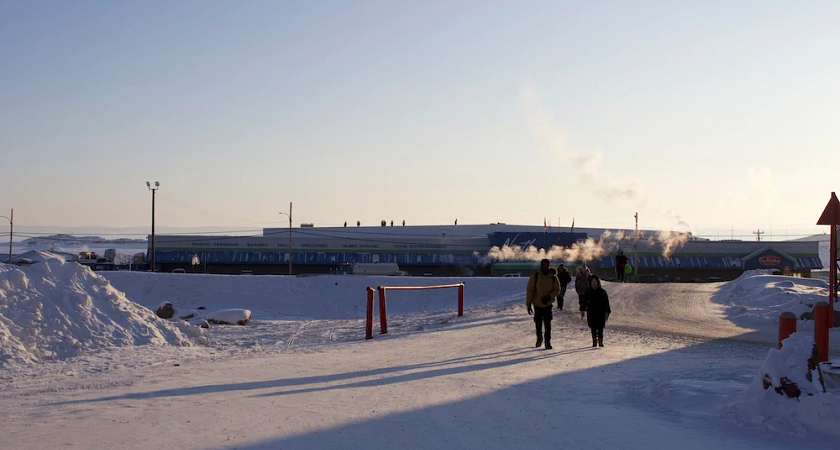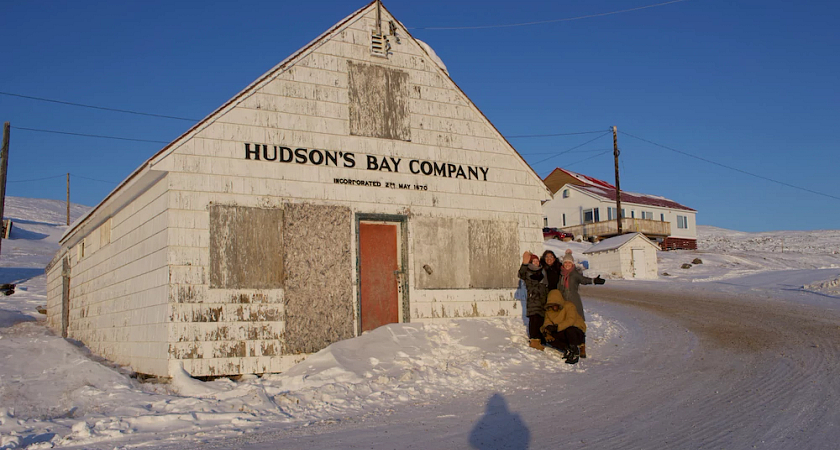This past February, two Arts Management students and three students from The Business School had the opportunity to travel to Iqaluit, Nunavut to engage in enriching and exciting work with Qaggiavuut- a non-profit organization that has a goal of strengthening and promoting Inuit culture and language through the performing arts. The students were able to assist with marketing and fundraising for Qaggiavuut’s campaign to build a Qaggiq: an Inuit Performing Arts and Cultural Learning Hub.
This applied research abroad program (ARAP) was arranged through Centennial’s SaGE program which aims to provide students with an opportunity to contribute to an applied research project. The work in Iqaluit went toward a credited course, which for Story Arts Centre students, was the Storyworks requirement. Rebecca Peirson, Instructor and Program Coordinator of the Arts Management program explains what occurred prior to the trip. “They had to meet as a group a few times before they left, in order to start to determine their scope of work for their week with Qaggiavuut,” she says. “Their biggest outcome for the week was to research partnership opportunities for Qaggiavuut in order to leverage their presence in the performing arts sector both in the north and south.”
Overall, Rebecca says the trip was excellent. “Both Centennial students and Qaggiavuut Executive Team and Board Members hugely benefited from the experience. The students were immersed in Inuit culture through the host organization as well as stakeholder visits, such as from CBC North, Tourism Society, Arctic College, Pirurvik Centre, and more,” she says. “Ellen Hamilton, Executive Director was a wealth of knowledge for the students and she made herself available to them as a resource during the week. As well, Qaggiavuut Board Members were present at various times throughout the week and available for interviews, questions, etc.” In terms of the work involved, Rebecca says, “The work the students did during the week culminated at an end of week presentation to Qaggiavuut leaders, artists, and board members. The students presented a comprehensive marketing and fundraising proposal backed up by research. Qaggiavuut was so impressed that they have stated they would like to work toward offering paid work this summer to at least one student to help with their marketing and fundraising efforts.”

The trip made such an abundant impact on everyone involved. Rebecca says, “I don’t think it would be a stretch to say it was life-altering for the students for a number of reasons. Two sets of students from different programs, who had not met each other until this opportunity, were quickly thrown into the mix of planning and preparing for a trip, although in Canada, in many respects, felt like a unique country of its own. The students were exposed to many facets in Iqaluit thanks to Qaggiavuut, the various stakeholder visits they did each afternoon, the famous wing night they checked out at the Storehouse, the famous museum, and more.”
James Nicholson, an Arts Management student, was one of the students who went on the trip. After taking this opportunity because of his commitment to never saying no to anything, he came to realize the trip meant more to him than he originally thought. He says, “The emotional aspect is what really got me and the other people on the team. It went from something that I was like, oh cool this will be a fun trip, to I would like to help them, and not in a, I’m someone who knows everything and I’m going to help you, but in a, I’ll do whatever I can and if you need my help, ask, because I’m happy to do it and because what you’re doing is important.'
The day-to-day activities varied, as James explains that they would work for five and a half hours every day in Qaggiavuut’s building and then there would be some type of excursion, such as a museum visit. “In the evening, there would always be some type of dinner with someone, such as a get-together or a community meeting,” he says. The evenings are when James would meet the local people. He says, “By the second day, I became friends with everyone and they invited me out to events.” In fact, he became friends with the caterer and was invited to get wings and join in at an open mic night. James explains that wing nights are always so popular, partly due to how inexpensive they are compared to other food in Iqaluit. To give you an idea, James explains that a small poutine is around $15!

James says it was enlightening to hear about Inuit culture as well as the inequalities that occur, which he explains made him really start caring about everything even more. He says, “The whole purpose of the [Qaggiq] is to keep Inuit art alive and let them have a place to work on it, train, and have an actual dedicated space to use for art, which is their storytelling.” James explains that art is a community where everyone should feel welcome and it is the hope that this would provide those who need it, a feeling of community.
The project was a perfect example of experiential learning as the students were able to have hands-on experience in the field. James recalls turning to another student on the trip and saying, “We have the knowledge, we have the experience, and we are ready to do this.” He said, “It’s nice to have that moment where you realize your hard work has paid off.”
This was such a meaningful experience and Centennial is extremely proud of the work put into this project! Also, a big thank you to James Nicholson for supplying the beautiful pictures within the article!
To learn more about Qaqqiavuut and the work they are doing, check out their website, here.
By: Alexandra Few, Communications - Professional Writing Student
